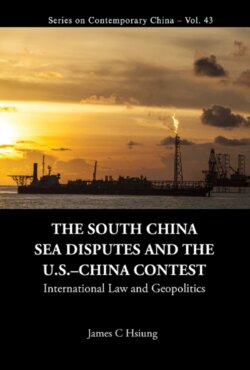Читать книгу South China Sea Disputes And The Us-china Contest, The: International Law And Geopolitics - James Chieh Hsiung - Страница 11
На сайте Литреса книга снята с продажи.
Highlight on SCS Resources: Competing Claims
ОглавлениеA 1968 U.N. report revealed the discovery of rich oil and natural gas deposits in the SCS, according to one source.3 This was echoed by a tweet on a Chinese blog, calling the SCS the “second Persian Sea” in reference to its vast oil deposits.4 The Council on Foreign Relations in New York gave a more modest, but still staggering, estimate: some 11 billion barrels of oil and 190 trillion cubic feet of natural gas deposits under the subsoil of the SCS.5
It may not be coincidental that the conflicts with China by some Southeast Asian contending neighbors, such as Vietnam and the Philippines, began to hike in the years immediately following 1968. For instance, the struggle over the Paracels between Vietnam and China began in 1970; and a war broke out in 1974, in which Vietnam was defeated, and China took back the complete control of the island group. On its part, the Philippines in 1971 announced its claim to islands in the Spratlys adjacent to its territory, which it renamed Kalayaan and incorporated into Palawan Province the following year.6 On March 11, 1976, the first Philippine oil company “discovered” an oilfield off Palawan island. Also in the 1970s, the Philippines, Malaysia, and other countries began referring to the Spratly islands as included in their own territory. President Ferdinand Marcos of the Philippines, for example, issued Presidential decree No. 1596, on June 11, 1978, declaring the Spratlys (referred to as the Kalayaan Island Group) as Philippine territory.7
To bring things up to date, the search for oil even brought India and Japan to the SCS, by means of cooperative deals signed with Vietnam in the early 21st century. On July 22, 2011, an Indian amphibious assault vessel, the INS Airavat, on a friendly visit to Vietnam, was contacted, some 45 nautical miles off the Vietnamese coast, by the Chinese navy that it was entering Chinese waters.8 In reply, the Indian side quipped that seeing no ship or aircraft in view, the INS Airavat just proceeded on her onward journey as scheduled. Citing freedom of navigation, it continued that the Indian vessel meant no harm or confrontation.9 In September 2011, shortly after Vietnam and China had signed an agreement seeking to contain a dispute over the SCS,10 India announced that ONGC Videsh Ltd, an Indian overseas investment company, had signed a three-year agreement with PetroVietnam for developing long-term cooperation in the oil sector. The announcement also said that India had accepted Vietnam’s offer of exploration in certain specified blocks in the SCS.11
Vietnam and Japan, early in 1978, also reached an agreement on the development of oil in the SCS. By 2012, Vietnam had concluded some 60 oil and gas exploration and production contracts with various foreign companies.12 There are reports that show that Vietnam, which used to be an oil-poor country, had an average production of 298 barrels of crude a day (298 BBL/D), during 1994–2016, making it an oil exporting country.13
As if not to be left behind, China’s first independently designed and constructed oil drilling platform in SCS, Ocean Oil 981 (海洋石油 981), also began its first drilling operation in 2012. The platform is located 320 km (c. 200 miles) southeast of Hong Kong.14
